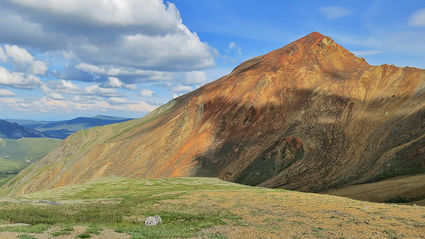Drills tap exceptional Red Mountain zinc
North of 60 Mining News – July 6, 2018
Last updated 9/25/2020 at 5:42am

White Rock Minerals Ltd.
White Rock Minerals' 2018 drill program has tapped high-grade zinc at the Dry Creek deposit in the foreground and the West Tundra Flats deposit in the distance.
White Rock Minerals Ltd. July 4 reported exceptional grades in the first two holes targeting the down plunge extension of mineralization in the Discovery and Fosters lenses of the Dry Creek volcanogenic massive sulfide deposit on the Red Mountain project in Interior Alaska.
Hole DC18-77 cut 4.26 meters averaging 4.8 percent zinc, 2.3 percent lead, 1,435 grams (46.1 ounces) per metric ton silver, 2.2 g/t gold and 0.5 percent copper – this is the equivalent of 43.2 percent zinc when you account for the value of all the metals. This was part of a 9.39-meter intercept of the Foster lens that averaged 2.6 percent zinc, 1.3 percent lead, 686 g/t silver, 1.1 g/t gold and 0.3 percent copper, or 21.1 percent zinc-equivalent.
The Australia-based explorer tapped even higher grade zinc mineralization in the Discovery lens.
Drilled about 900 meters east of hole 77, DC18-79 cut 4.72 meters averaging 19.5 percent zinc, 7.8 percent lead, 466 g/t silver, 6.9 g/t gold and 1.5 percent copper, or 49.7 percent zinc-equivalent. This was part of a 16-meter intercept of the Discovery lens that averaged 6.4 percent zinc, 2.6 percent lead, 152 g/t silver, 2.2 g/t gold and 0.5 percent copper, or 16.1 percent zinc-equivalent.
"This drilling represents a significant extension to the Dry Creek deposit and notably down dip at both the Fosters and Discovery lenses," said White Rock CEO Matt Gill. "These first two extension drill holes highlight the upside potential for a significant expansion to the Resource at Dry Creek, both in terms of grade and size."
The company said the Dry Creek deposit shows the pinching and swelling of mineralization often encountered in VMS deposits.
"Dry Creek is an exciting VMS deposit as it shows great variation in thickness that has the potential to rapidly add to the resource," said Gill. "In addition, we are continuing to see more copper as we explore to the east, supporting an early interpretation that the VMS system may be improving towards the east and at depth, where improving zinc grades could also be expected."
White Rock is testing this upside potential with drilling that is targeting eastern extensions of the Discovery lens. Assays are pending on two additional holes already completed at Dry Creek and another hole is underway.
WTF high grades
Last year, Australia-based White Rock commissioned a resource calculation for the two main deposits at Red Mountain – Dry Creek and West Tundra Flats – that meets modern reporting standards.
This maiden Australian Joint Ore Reserves Committee- (JORC) compliant calculation outlined 16.7 million metric tons of inferred resource averaging 4.1 percent (1.49 billion pounds) zinc; 1.7 percent (630 million lb) lead; 0.2 percent (57.3 million lb) copper; 99 grams per metric ton (53.5 million oz) silver; and 0.7 g/t (352,000 oz) gold.
The initial focus of the 2018 drill program at Red Mountain, which got underway in May, is on upgrading and expanding these deposits.
In June the company reported high-grade results from drilling at West Tundra Flats, referred to as WTF, about 3,000 meters northeast of Dry Creek.
WT18-28 cut 3.45 meters averaging 15.1 percent zinc, 6.7 percent lead, 518 g/t silver, 2.1 g/t gold and 0.2 percent copper, or 35.2 percent zinc-equivalent.
"These first drill assay results for the Dry Creek and West Tundra deposits validate our belief that these two deposits form part of a genuine high-grade zinc-rich polymetallic VMS mineralization system," said Gill. "Our exploration program focus is to expand the maiden resource and to identify and test new targets to make the additional discoveries."
Powerful exploration tool
As drills target high-grade expansions of the known resource at Red Mountain, crews carried out geophysical surveys, mapping and sampling across the deposits. By comparing the results with what is known about the mineralization there, this orientation exercise is helping to determine the best exploration tools to use to prioritize the 30 earlier staged prospects across the roughly 35,000-acre property.
This orientation work found that highly conductive anomalies that were easily identifiable with both controlled-source audio-frequency magnetotellurics, or CSAMT, and time-domain electromagnetic surveys carries the high-grade mineralization at Dry Creek.
White Rock has chosen CSAMT as its preferred geophysical tool due to the quicker acquisition of data.
In addition to finding exploration targets across the wider Red Mountain property, on-ground CSAMT surveys are being used to targets extensions of the high-grade resource already outlined there.
"The stark conductivity anomaly results seen and their coincidence with known massive sulfide mineralization gives White Rock a powerful exploration tool with which to identify new targets for drill testing, hopefully leading to resource expansion and the discovery of new deposits," said Gill.
–SHANE LASLEY



Reader Comments(0)